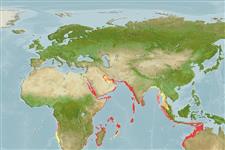Cheimerius nufar (Valenciennes, 1830)
Santer seabream
個人による観察記録の追加 Fish Watcher
| Native range | All suitable habitat | Point map | Year 2050 |

|
| This map was computer-generated and has not yet been reviewed. |
| Cheimerius nufar AquaMaps Data sources: GBIF OBIS |
Upload your 写真 and ビデオ
Pictures | グーグルの画像Cheimerius nufar
Picture by Randall, J.E.
Pictures | グーグルの画像Cheimerius nufar
Picture by Randall, J.E.
Bahrain country information
Common names:
[No common name]
Occurrence: native
Salinity: marine
Abundance: | Ref:
Importance: | Ref:
Aquaculture: | Ref:
Regulations: | Ref:
Uses: no uses
Comments:
National Checklist:
Country Information: https://www.cia.gov/library/publications/resources/the-world-factbook/geos/ba.html
National Fisheries Authority:
Occurrences: Occurrences Point map
Main Ref: Smith, J.L.B. and M.M. Smith, 1986
National Database:
Occurrence: native
Salinity: marine
Abundance: | Ref:
Importance: | Ref:
Aquaculture: | Ref:
Regulations: | Ref:
Uses: no uses
Comments:
National Checklist:
Country Information: https://www.cia.gov/library/publications/resources/the-world-factbook/geos/ba.html
National Fisheries Authority:
Occurrences: Occurrences Point map
Main Ref: Smith, J.L.B. and M.M. Smith, 1986
National Database:
Common names from other countries
分類 / Names 共通名の | 類義語 | Catalog of Fishes(部類, 種) | ITIS | CoL | WoRMS | Cloffa
> Eupercaria/misc (Various families in series Eupercaria) > Sparidae (Porgies)
More on author: Valenciennes.
More on author: Valenciennes.
Environment: milieu / climate zone / depth range / distribution range 生態学
海 関連する礁; 深さの範囲 20 - 300 m (Ref. 28016). Tropical; 32°N - 28°S
分布 国々 | 国連食糧農業機関の区域 | エコシステム | 事件 | Point map | 導入 | Faunafri
Western Indian Ocean: Red Sea south to Mossel Bay, South Africa and east to India and Sri Lanka.
Length at first maturity / サイズ / 重さ / 年齢
Maturity: Lm 34.6, range 35 - 45 cm
Max length : 75.0 cm TL オス/雌雄の選別がない; (Ref. 30573); common length : 30.0 cm TL オス/雌雄の選別がない; (Ref. 3507)
Max length : 75.0 cm TL オス/雌雄の選別がない; (Ref. 30573); common length : 30.0 cm TL オス/雌雄の選別がない; (Ref. 3507)
簡単な記述 検索表 | 形態学 | 形態計測学
背面の脊椎 (合計) : 11 - 12; 背鰭 (合計) : 10 - 11; 肛門の骨: 3; 臀鰭: 8. Silvery with faint, red crossbars; dead specimens almost white or purple.
Found over rocky substrates of coastal waters. Juveniles stay in sheltered areas of estuaries (Ref. 5213). Large specimens caught from the shore only when seas are rough (Ref. 3198). Marketed fresh, whole or dried.
Life cycle and mating behavior 成熟 | 繁殖 | 放精 | 卵 | 生産力 | 幼生
Also reported as a 'rudimentary hermaphrodite' or 'late gonochorist' where individuals posses an immature intersexual gonad but mature as either male or female fish with no eveidence of sexual reversal (Ref. 28504).
主な参考文献
Upload your references | 参考文献 | コーディネーター | 協力者
Bauchot, M.-L. and M.M. Smith, 1984. Sparidae. In W. Fischer and G. Bianchi (eds.) FAO species identification sheets for fishery purposes. Western Indian Ocean (Fishing Area 51). volume 4. [var. pag.] FAO, Rome. (Ref. 3507)
人間に対する脅威
Harmless
Human uses
水産業: 少数商業の
FAO(水産業: 代謝; publication : search) | FishSource | 私達の周りの海
より多くの情報
Population dynamics
成長のパラメーター
Max. ages / sizes
Length-weight rel.
Length-length rel.
体長組成
Mass conversion
補充
豊度
成長のパラメーター
Max. ages / sizes
Length-weight rel.
Length-length rel.
体長組成
Mass conversion
補充
豊度
Anatomy
カマ
Brain
Otolith
カマ
Brain
Otolith
Physiology
Body composition
Nutrients
酸素消費
水泳形態
泳ぐ速さ
Visual pigments
Fish sound
Diseases & Parasites
Toxicity (LC50s)
Body composition
Nutrients
酸素消費
水泳形態
泳ぐ速さ
Visual pigments
Fish sound
Diseases & Parasites
Toxicity (LC50s)
Genetics
遺伝子の
Heterozygosity
遺伝
遺伝子の
Heterozygosity
遺伝
用具
E-book | 野外観察図鑑 | Length-frequency wizard | 生活史の基盤ツール | 目的のマップ | Classification Tree
| Catch-MSY |
特記事項
XMLをダウンロードして下さい
インターネットの情報源
Aquatic Commons | BHL | Cloffa | Websites from users | Check FishWatcher | CISTI | Catalog of Fishes(部類, 種) | DiscoverLife | ECOTOX | Faunafri | Fishtrace | GenBank(ゲノム, ヌクレオチド) | GloBI | GOBASE | | Google Books | Google Scholar | Google | IGFA World Record | MitoFish | Otolith Atlas of Taiwan Fishes | PubMed | Reef Life Survey | Scirus | SeaLifeBase | 生命の木 | Wikipedia(行く, 検索する) | World Records Freshwater Fishing | 動物に関する記録
Estimates based on models
Preferred temperature (Ref. 115969): 17.8 - 27.7, mean 23.9 (based on 306 cells).
Phylogenetic diversity index (Ref. 82804): PD50 = 1.0000 [Uniqueness, from 0.5 = low to 2.0 = high].
Bayesian length-weight: a=0.01380 (0.01215 - 0.01568), b=3.04 (3.01 - 3.07), in cm Total Length, based on LWR estimates for this species (Ref. 93245).
栄養段階 (Ref. 69278): 3.5 ±0.4 se; based on diet studies.
回復力 (Ref. 120179): 低い, 4.5年~14年の倍増期間の最小個体群 (K=0.07-0.18; tmax=22).
Fishing Vulnerability (Ref. 59153): High vulnerability (60 of 100).
Climate Vulnerability (Ref. 125649): High vulnerability (60 of 100).




